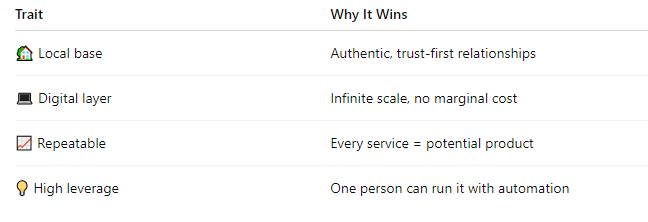Small Shop, Global Reach: The Hybrid Model Powering $10K/Month Solopreneurs
Why It’s Hot
For decades, “local services” meant barbershops, yoga studios, and dog walkers. Grounded in place. Dependent on foot traffic. Capped by geography.
But something shifted.
When the pandemic forced local operators online, some cracked a deeper insight:
Going digital isn’t just survival — it’s leverage.
Now, a new wave of “hybrid local services” is quietly scaling far beyond their zip codes. They’re built with local roots, but global reach. A bike mechanic in Toronto now sells video consults in Berlin. A chef in Brooklyn teaches a dinner class to 500 people in four time zones. A Lisbon photo guide turns walking tours into downloadable city presets.
The unlock is simple but powerful:
Local trust creates demand. Digital delivery unlocks scale.
This new model — part community, part content, part commerce — is producing a wave of small-but-scalable businesses. And they look nothing like traditional local service plays.
The Big Idea & Value Proposition
This isn’t about replacing physical work with digital work. It’s about embedding digital revenue into existing local services — then exporting it.
Think of it as: “hyperlocal credibility → global income stream.”
Here’s how hybrid service models typically work:
🧩 Start with a niche service people already trust you for (accounting, photography, cooking, fitness)
🎥 Add a digital layer — consulting calls, online workshops, templates, subscriptions, community
🚚 Keep the local presence, but let digital sales drive scale
For users:
Locals still get the human, place-based connection
Remote audiences get access to authentic, differentiated value
For founders:
No need to hire staff or open a second location
Margins are better, distribution is wider, and marketing scales through content
Whether you’re a dog trainer or a ceramicist, the model is clear:
Serve your neighborhood. Sell to the world.
The Market & The Players
This shift sits at the intersection of multiple exploding trends:
What’s new is how small operators are stacking digital on top of IRL:
A dog groomer runs a $50/month pet-care tips newsletter
A cycling repair shop sells $99 DIY bike tune-up courses
A yoga instructor earns more from online classes than from studio memberships
This isn’t hypothetical. You can see it in platforms like:
But the biggest enabler? Trust.
If people know you as “the local expert,” you don’t need to build brand awareness — just redirect it online.
How It Makes Money & Grows
Hybrid services make money through a mix of direct services, digital products, and subscriptions.
Growth is driven by:
📍 Trust loops — Locals talk, leave reviews, share content
📹 Content flywheels — Short-form video → course sales
📬 Lightweight landing pages — Turn services into scalable products
You don’t need millions of views. You need a niche, a system, and a story.
The Playbook: From Pilot to Scale
Here’s a lean way to build this in 6 steps:
Start with a local pain point
Something people already ask you for help with — meals, design, advice, photos.Productize 1 offer digitally
Package your know-how into a 30-minute call, a Notion template, or a $20 guide.Test it with your real-world clients
Offer it to your in-person customers first — they already trust you.Launch with just content + link
Post on TikTok, Instagram Reels, or in local Facebook groups. Add a bio link. Done.Automate later with tools
Calendly, Gumroad, ConvertKit, Kajabi — use these when demand picks up.Stack repeatables
Add a paid newsletter. Record your classes. Sell a kit. Run a cohort. Build a bundle.
You don’t need a storefront. You need proof.
And once locals buy in? The rest of the world follows.
📌 Summary Table: Why Hybrid Services Work
Final Take
In a world of faceless global brands, local still wins on trust.
But now, local doesn’t have to mean small.
Whether you’re a baker, a builder, or a bike mechanic, the new path is clear:
Start with your block. Sell to the world.
This isn’t just a new kind of local service.
It’s a new kind of business.





